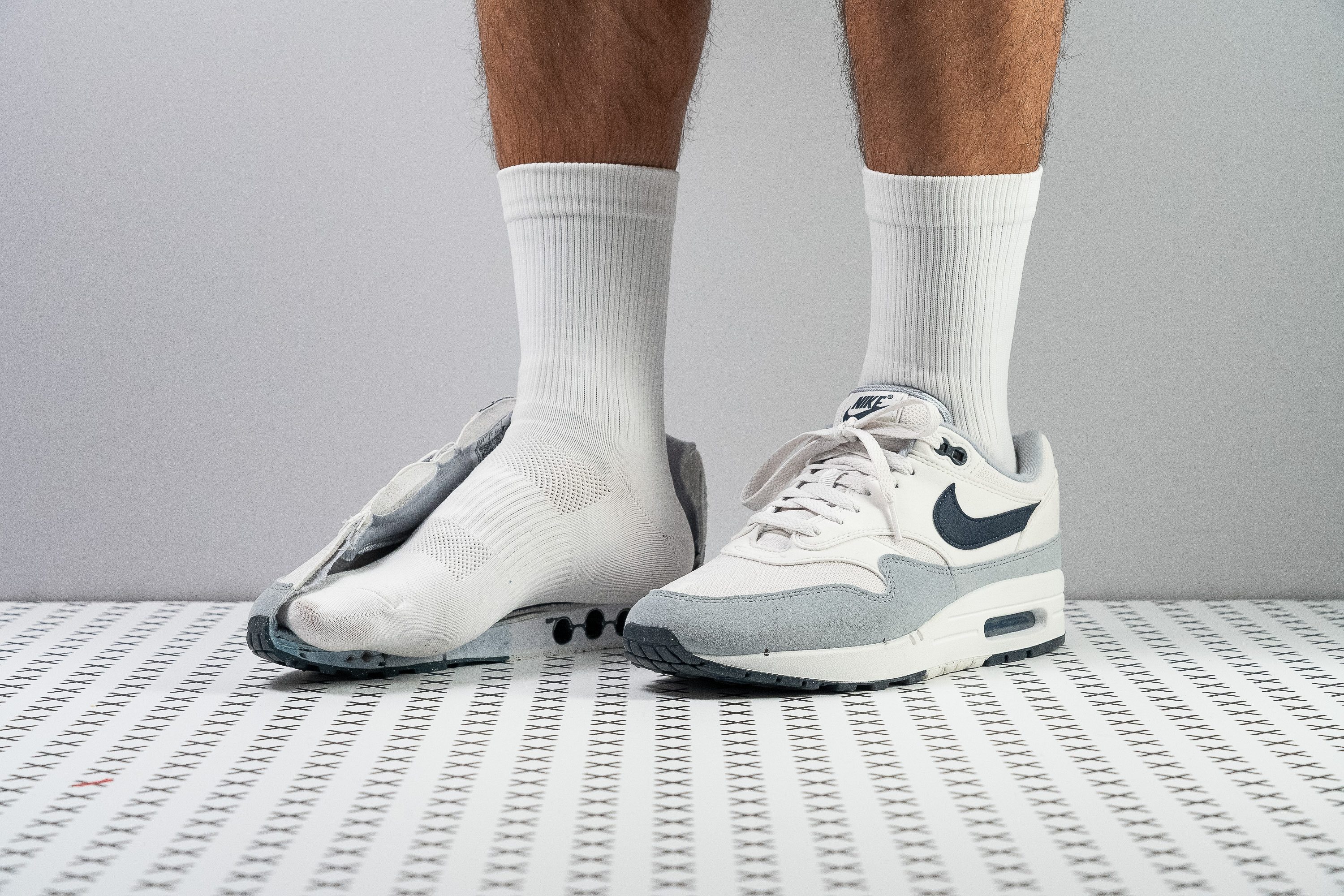Our verdict
- Top pick in best Nike trainers
Pros
- Historical silhouette (first-ever visible Air Max)
- Responsive Air Max cushioning
- Comfortable for all-day wear
- Very supportive construction
- Extraordinary durable
- Lighter than expected
- True to size and fit
- Great outsole grip
Cons
- Lacks breathability
- Really stiff platform
- Cheap materials (fake leather and suede)
Audience verdict
- Top 24% in trainers
- Top 21% in Nike trainers
Comparison
The most similar trainers compared
+ + Add a shoe | |||||
|---|---|---|---|---|---|
| Audience score | 93 Great! | 87 Good! | 95 Superb! | 93 Great! | |
| Price | £135 | £170 | £115 | £160 | |
| Style | ClassicSporty | ClassicRetroSportyChunky | DadRetroSporty | ClassicSportyFuturisticChunky | |
| Shock absorption | Moderate | - | High | Moderate | |
| Energy return | Moderate | - | Moderate | Moderate | |
| Traction | Moderate | - | High | High | |
| Breathability | Warm | Breathable | Warm | Moderate | |
| Weight lab | 13.3 oz / 378g | 14 oz / 397g | 12.9 oz / 366g | 15.1 oz / 427g | |
| Size | True to size | True to size | True to size | True to size | |
| Midsole softness | Balanced | Balanced | Soft | Soft | |
| Material | Mesh | LeatherMeshSuede | LeatherMesh | MeshSuede | |
| Season | SpringFall | Summer | SpringFall | SpringFall | |
| Inspired from | Running | Running | Running | Running | |
| Width / fit | Medium | Medium | Medium | Medium | |
| Toebox width | Medium | Medium | Medium | Narrow | |
| Leather/suede quality | Fake suede | Real leather | Real leather | Real suede | |
| Toebox durability | Decent | Decent | Decent | Decent | |
| Heel padding durability | Decent | Decent | Decent | Decent | |
| Outsole durability | Good | Good | Good | Good | |
| Heel stack lab | 32.2 mm | 34.8 mm | 32.3 mm | 37.3 mm | |
| Stiffness | Stiff | Stiff | Moderate | Moderate | |
| Tongue padding | Average | Average | Average | Average | |
| Drop lab | 12.1 mm | 10.3 mm | 10.0 mm | 11.3 mm | |
| Forefoot | 20.1 mm | 24.5 mm | 22.3 mm | 26.0 mm | |
| Removable insole | ✓ | ✓ | ✓ | ✓ | |
| Heel tab | None | None | None | None | |
| Torsional rigidity | Stiff | Stiff | Moderate | Moderate | |
| Heel counter stiffness | Moderate | Moderate | Moderate | Moderate | |
| Reflective elements | ✗ | ✓ | ✗ | ✓ | |
| Closure | Laces | Laces | Laces | Laces | |
| Top | Low top | Low top | Low top | Low top | |
| Ranking | #29 Top 24% | #105 Bottom 13% | #7 Top 6% | #22 Top 19% | |
| Popularity | #48 Top 40% | #82 Bottom 32% | #4 Top 4% | #1 Top 1% |
Who should buy
You can't walk past the Nike Air Max 1 if:
- you are building an Air Max collection (this is a must-have)
- you want an iconic sneaker that doesn't cut corners on comfort and support
- you love the bouncy experience of Air Max technology
- retro kicks are your fancy
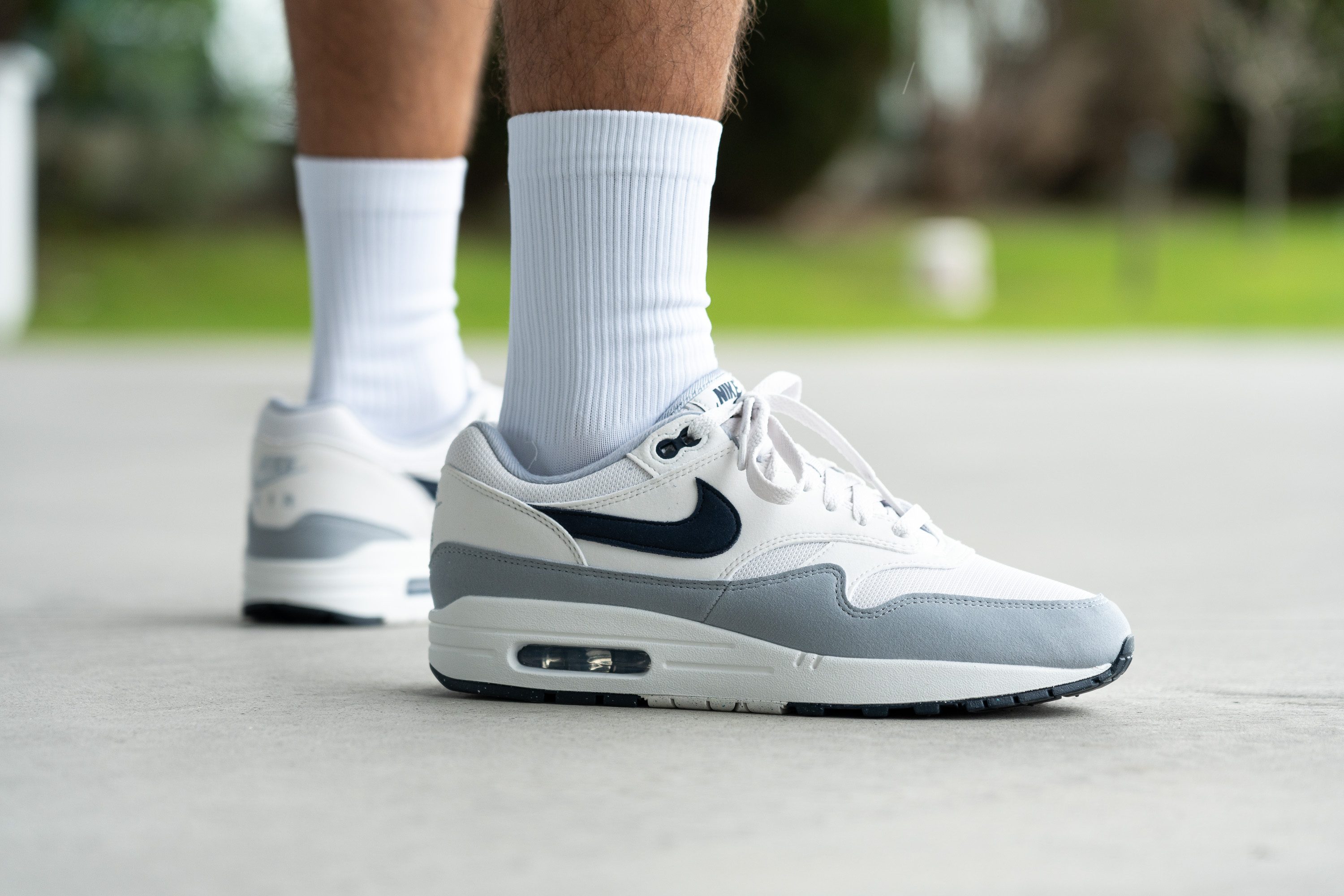
Who should NOT buy
If you really want an Air Max silhouette but the shoe's fake leather-suede upper annoys you, consider getting a slightly more expensive Premium version of the sneaker (£150-160) or consider the Nike Air Max 95.
On the other hand, if you want to experience the Air Max cushioning in a more affordable package, we highly recommend the Nike Air Max Excee.

Cushioning
Shock absorption
Most iconic trainers from the past often leave you with a choice: it's either style or comfort. But the Nike Air Max 1 walks a fine line between both, offering good impact protection for long hours on your feet.
Recording the shoe's shock absorption at 88 SA, the AM 1 is not the most cushioned Air Max sneaker (many of which surpassed the 100 SA mark), but it can ease the pressure on your feet and joints well enough.

| Air Max 1 | 88 SA |
| Average | 89 SA |
Energy return
We experienced a well-balanced ride in this Nike kick, as it was neither too flat nor bouncy. With a moderate energy return of 51%, it has a decent midsole rebound that makes the walk quite enjoyable.
| Air Max 1 | 50.8% |
| Average | 50.2% |
Heel stack
Loaded with a large Air Max unit under the heel, it is no surprise that the Air Max 1 has a taller-than-average stack height.
Our calliper returned 32.3 mm as we measured its thickness in the heel.

Treated to so much cushioning underfoot, we felt pretty comfortable spending a whole day in the Air Max 1.
It is not as cosy as the brand's walking-oriented shoes like the Nike Motiva but it is one of the few fashion-statement trainers that are actually foot-friendly.
| Air Max 1 | 32.2 mm |
| Average | 30.7 mm |
Forefoot stack
Having cut the shoe in half, we were pleasantly surprised that it comes with an additional Air unit in the forefoot!
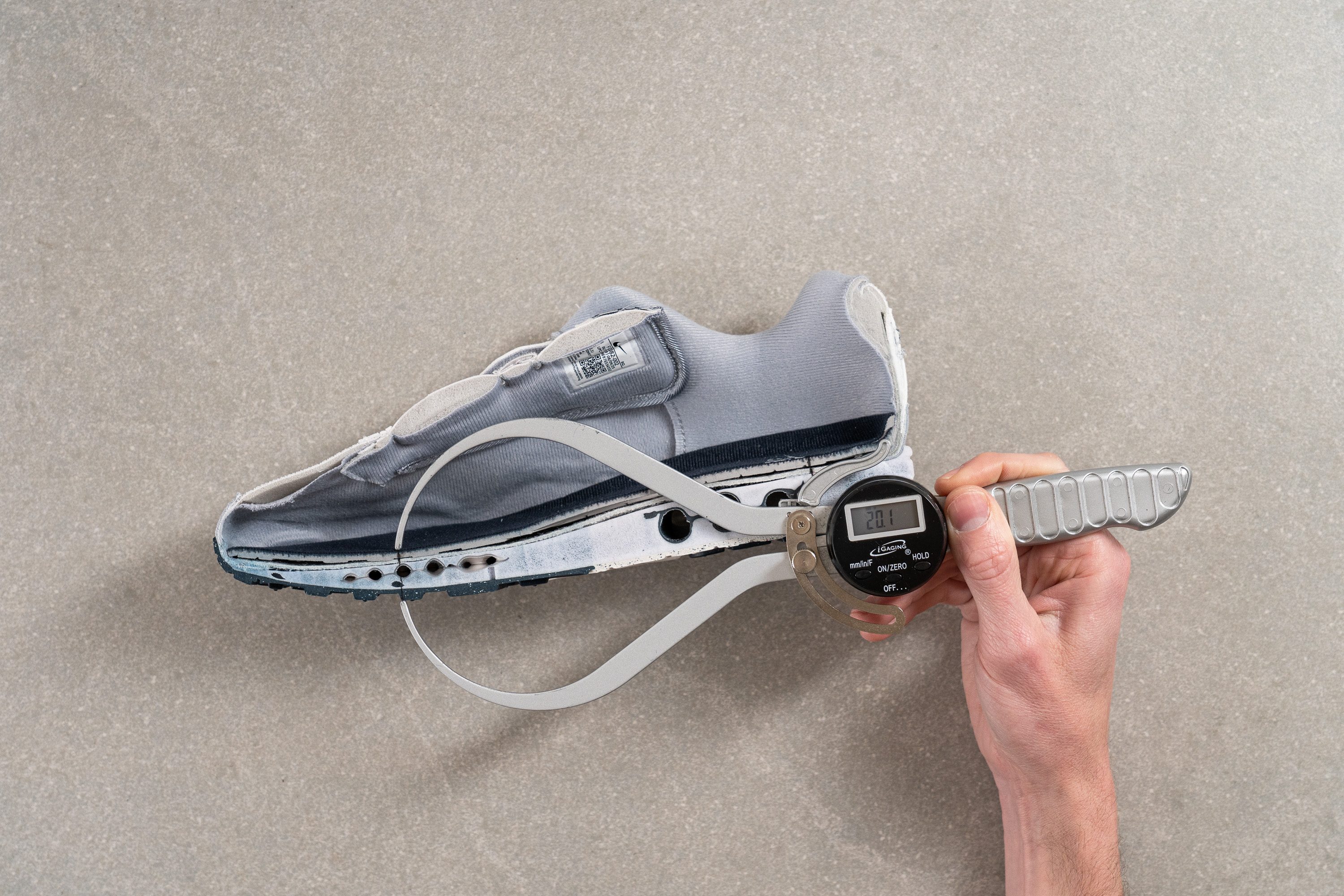
It is not as large as the heel unit but offered a very welcome touch of comfort and support for the balls of our feet.
It also added a couple of millimetres to the shoe's forefoot stack which showed 20.1 mm on our calliper.
| Air Max 1 | 20.1 mm |
| Average | 19.5 mm |
Drop
WIth a drop of 12.1 mm, the heel of the Air Max 1 is notably elevated above the toes.

However, once the shoe is loaded with the wearer's weight, the Air Max unit compresses and lowers the drop slightly.
In the end, this Nike shoe feels like most other trainers, with the heel placed slightly higher on the platform to take the pressure off the Achilles.
| Air Max 1 | 12.1 mm |
| Average | 11.2 mm |
Midsole softness
If you haven't experienced Nike trainers with Air Max cushioning before, you might be surprised with the Air's somewhat firm nature. That's because it is basically a sealed bag with pressurised gas.
But when it's loaded with your body weight, the Air Max comes into play adding a bit of bounce to your step. And the great thing about it is that it doesn't compress over time like the cushioning foams do!
By the way, we also checked the softness of the midsole foam that carries the Air bubble. With a durometer reading of 21.1 HA, it is 45% softer than average!
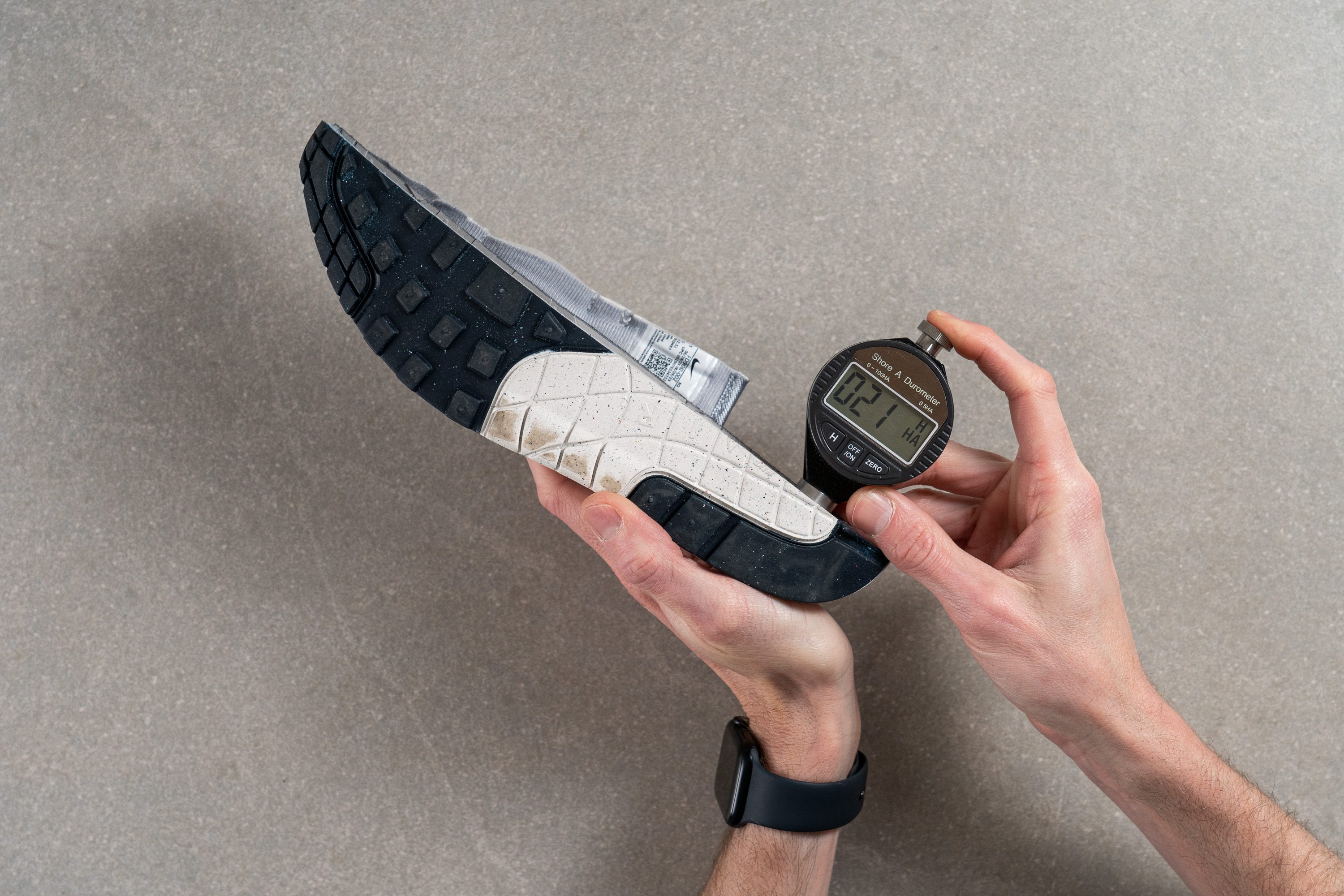
It adds a great deal of comfort to this Nike sneaker as well.

P.S. The Air Max unit of this particular iteration is smaller than it was in the original Nike Air Max 1 shoe from 1987. Nike decided to make it smaller in response to numerous complaints of the airbag cracking in low temperatures.
But if you prefer the look and feel of the larger Air Max unit, you might enjoy the Nike Air Max 1 '86 edition called the "Big Bubble." It was released in 2023 to commemorate the silhouette's 35th anniversary and recreate the authentic design. The retail price of this edition is a bit higher at £150-160.
| Air Max 1 | 21.1 HA |
| Average | 28.6 HA |
Size and fit
Size
Nike Air Max 1 fits true to size (420 votes).
Internal length
The Nike Air Max 1 runs true to size based on our personal experience and lab measurements.

Measuring the shoe's internal length in our men's US size 9, the ruler showed 271.8 mm.
This corresponds to the MM measurements in Nike's shoe size chart and is consistent with other popular sneaker from the brand, including the Nike Air Force 1 07.
| Air Max 1 | 271.8 mm |
| Average | 272.3 mm |
Width / Fit
We found the Nike Air Max 1 to be a well-fitting sneaker which is true to its D medium width. Gladly, our calliper measurements confirmed it.
Measuring the widest part of the mould, we got a regular (even slightly above-average) reading of 93.6 mm.

| Air Max 1 | 93.6 mm |
| Average | 92.5 mm |
Toebox width
The taper angle is pretty moderate too. The mold gets slightly narrower towards the toes but doesn't get any pointier than the average. At the big toe mark, it showed a standard width of 68.6 mm.
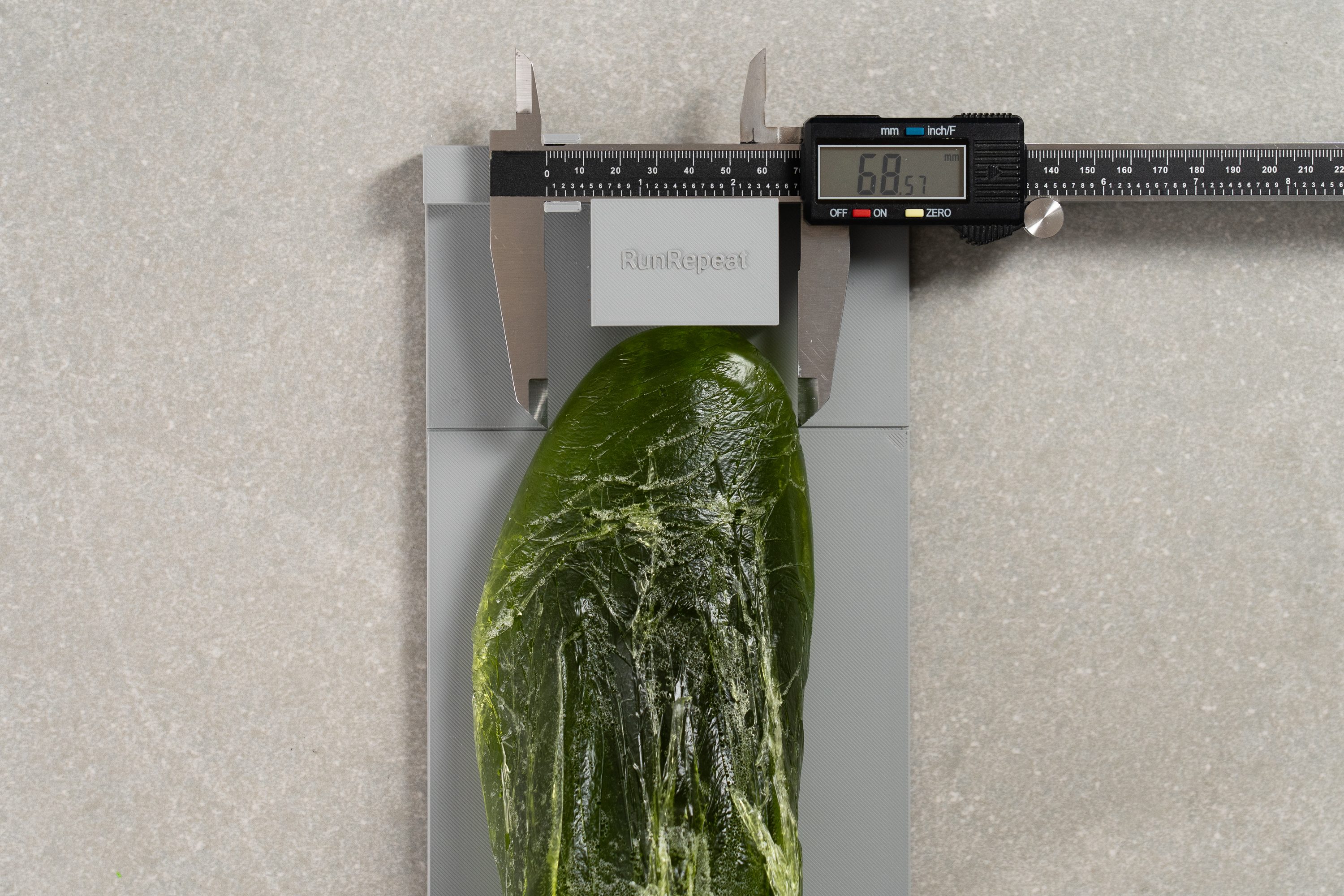
| Air Max 1 | 68.6 mm |
| Average | 68.9 mm |
Toebox height
The Air Max 1's toebox is not a shallow one either. Our calliper recorded a regular toebox height of 26.5 mm here.

| Air Max 1 | 26.5 mm |
| Average | 27.8 mm |
Traction / Grip
We rarely find ourselves in dire need of a strong grip in day-to-day life.
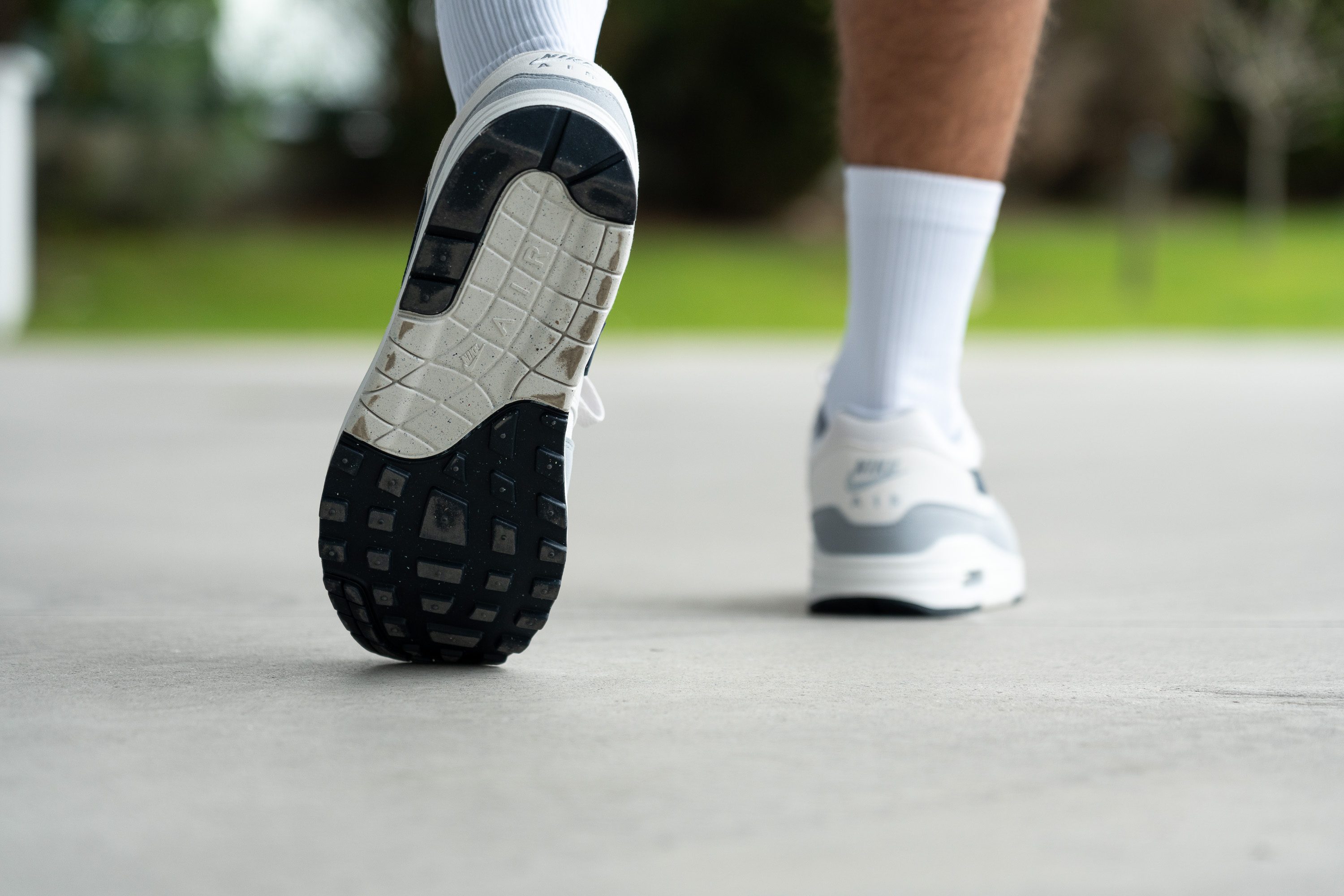
But the waffle outsole of the Nike Air Max 2 made us feel quite secure in common lifestyle situations like walking on wet stairs after the rain or stepping on tile floors of the coffee shop.
Traction test
The Nike Air Max 1 was made for the city streets and it gets its job done.
Testing its heel friction with a repeated stomping action at a 7-degree angle, our machine recorded a solid friction score of 0.44. This is a great result for a casual sneaker that's regularly used on dry concrete, asphalt, stone, and other common urban surfaces.
But as in most lifestyle trainers, you want to navigate slippery surfaces like wet stone and tiles carefully.
| Air Max 1 | 0.44 |
| Average | 0.43 |
Outsole design
The Air Max 1 features a pretty aggressive waffle treading in the forefoot complementing the shoe's retro appeal.
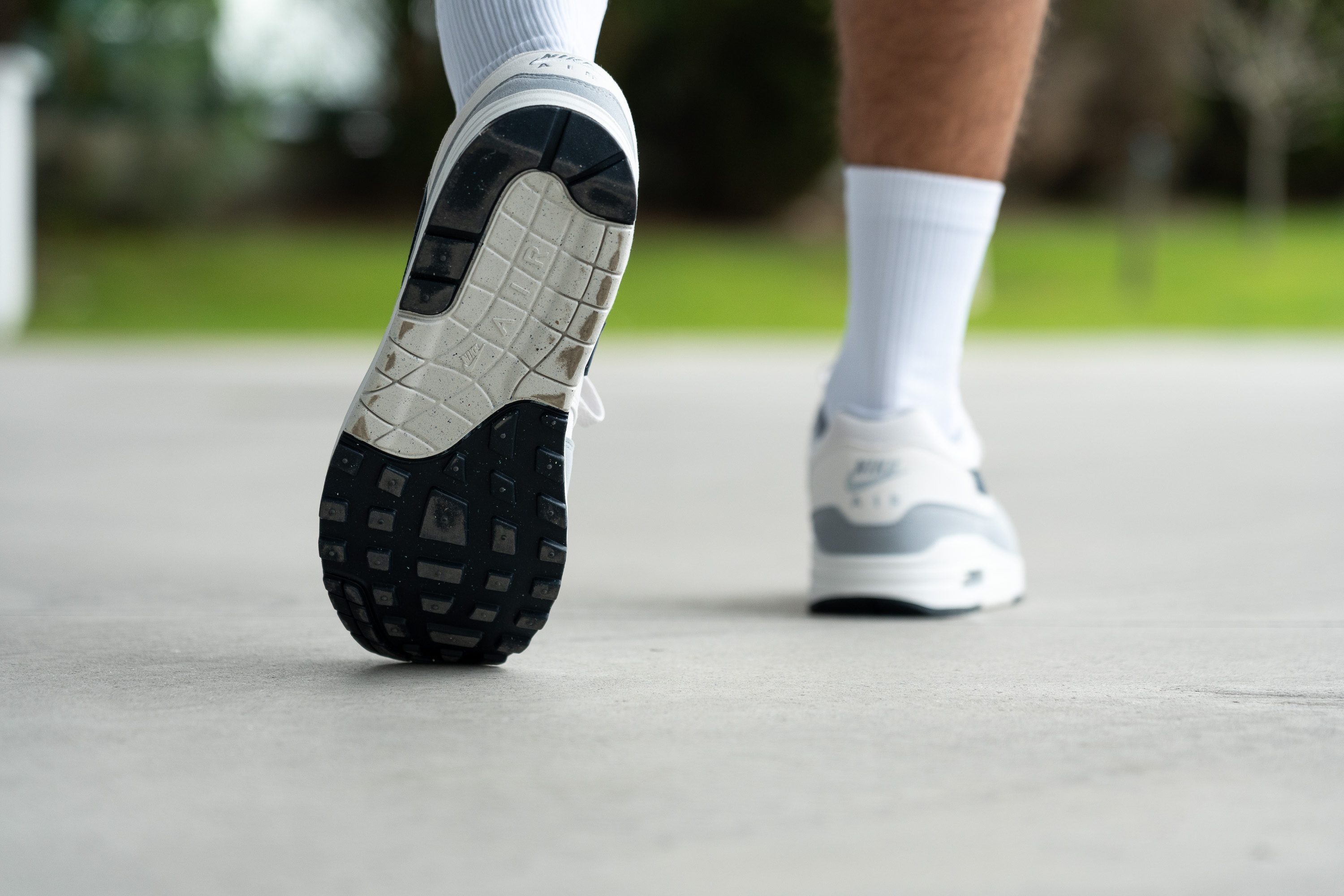
Flexibility / Stiffness
With its substantial midsole and rigid construction, the Air Max 1 wasn't very eager to bend with our foot. This was especially apparent at the toe-off.

The shoe's stiffness was also confirmed in our flexibility machine test. The latter showed that it takes an above-average amount of force (17.9N) to bend this Nike sneaker to a 30-degree angle. That's about 30% stiffer than it t akes an average sneaker.
| Air Max 1 | 17.9N |
| Average | 13.3N |
Weight
We were amazed at how Nike managed to keep the weight of the Air Max 1 below average. Our scale shows a moderate reading of 13.3 oz (378g) in a men's US size 9.

It is lighter than both the Nike Dunk Low (14.8 oz/420g) and the Nike Air Force 1 07 (16.4 oz/465g).
Considering the shoe's stack height, the Air units, and the somewhat beefy upper design, it feels pretty light on the foot.
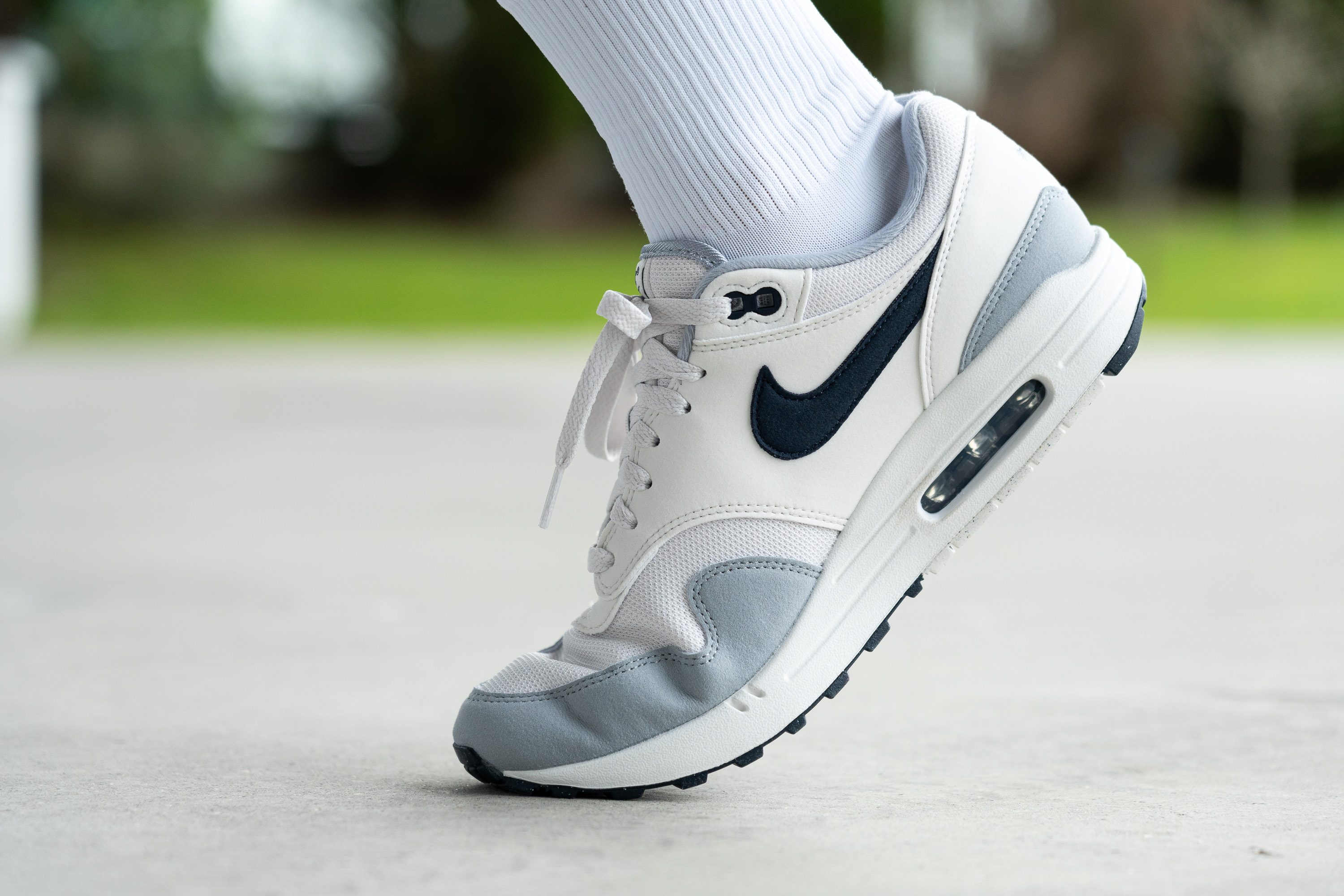
| Air Max 1 | 13.3 oz (378g) |
| Average | 13.8 oz (390g) |
Breathability
It is easy to be misled by the shoe's seemingly breathable mesh upper. But in reality, it hardly lets any air in or out of the interiors.
Our smoke-pumping breathability test makes it very clear that the shoe's ventilation capacity is little to none. Its toebox fabric failed to expel any smoke, unlike the much more breathable NB 57/40 shoe on the right.
Our additional search for ventilation holes didn't retrieve any results either.
Even in our microscope test, the shoe's upper fabric proved to be incredibly tightly woven with no pores in between the threads.

Thus, we couldn't rate the Air Max 1's breathability any higher than 2 out of 5.
This sneaker is not a good choice for warm summer days. We recommend looking into the Nike Zoom Vomer 5 among other top picks for summer if you are after highly breathable kicks.
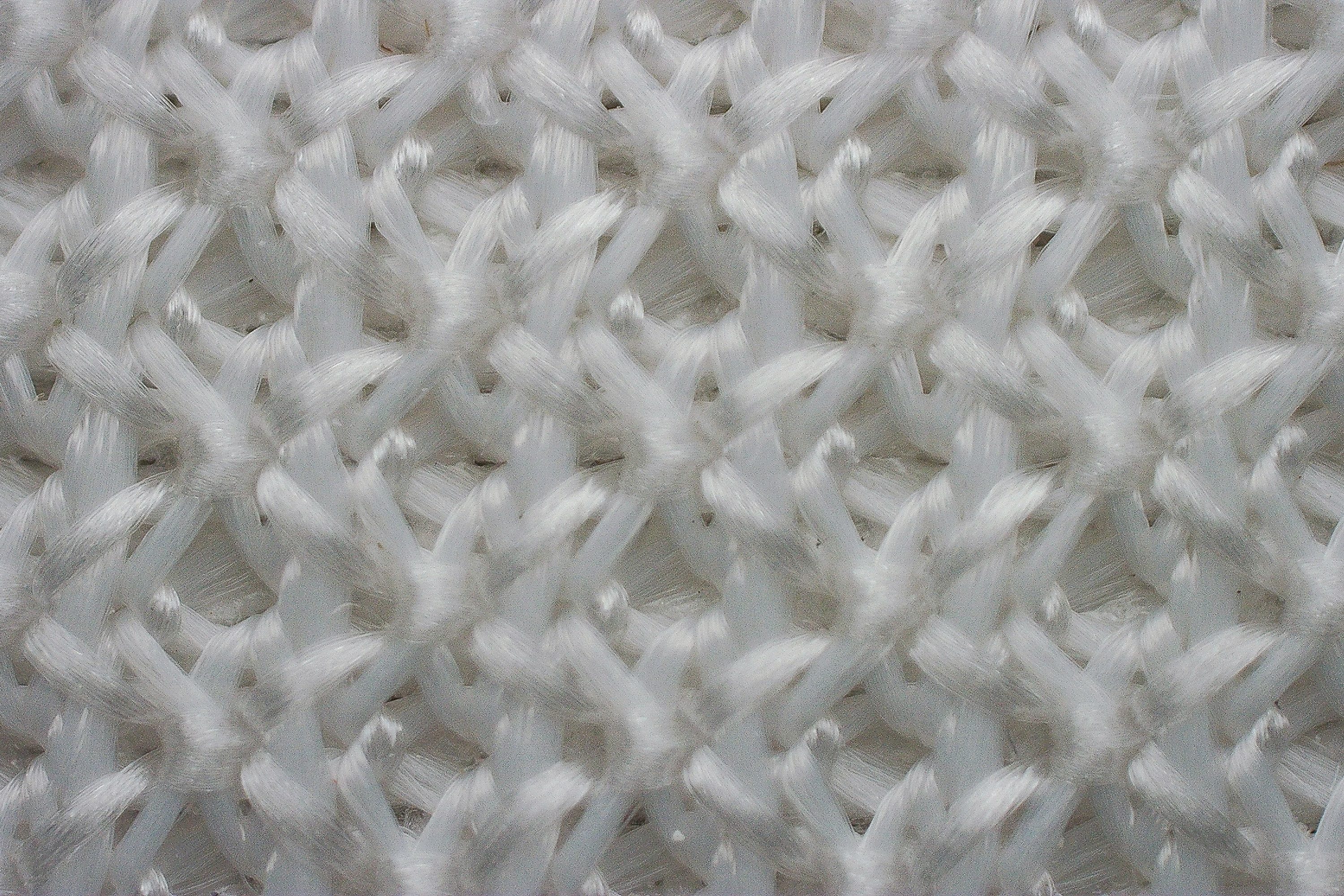
| Air Max 1 | 2 |
| Average | 3 |
Stability
Lateral stability test
Despite its air-based cushioning, the Nike Air Max 1 doesn't feel wobbly one bit!
The shoe's sturdy platform with raised sidewalls offered a very firm containment, never letting our feet or ankles get out of control.
We think that this Nike sneaker might even suit people with moderate overpronation (excessive inward rolling of the foot).
Torsional rigidity
Our manual test proved that it is nearly impossible to twist the Nike Air Max 1 sideways.
We gave the shoe a solid 5 out of 5 in a torsional rigidity assessment. It makes the foot feel very well-supported and stable.
| Air Max 1 | 5 |
| Average | 3.6 |
Heel counter stiffness
A considerable amount of support also comes from the shoe's heel counter which is structured, well-padded, and reasonably stiff.
Giving it a push-and-squeeze in our manual test, we assessed its level of stiffness at 3 out of 5.
Holding the back of our foot firmly in place, the shoe's heel counter prevented any unwanted slippage or shifting.
| Air Max 1 | 3 |
| Average | 3.2 |
Midsole width - forefoot
The platform of the Nike Air Max 1 is neither too wide nor too narrow. It sits right at the average of most trainers on the market.

Showing 107.9 mm in the widest part of the forefoot, it proved to be sufficiently wide to keep us surefooted.
| Air Max 1 | 107.9 mm |
| Average | 108.9 mm |
Midsole width - heel
We also found the heel of the Nike Air Max 1 to be broad enough to provide stability.
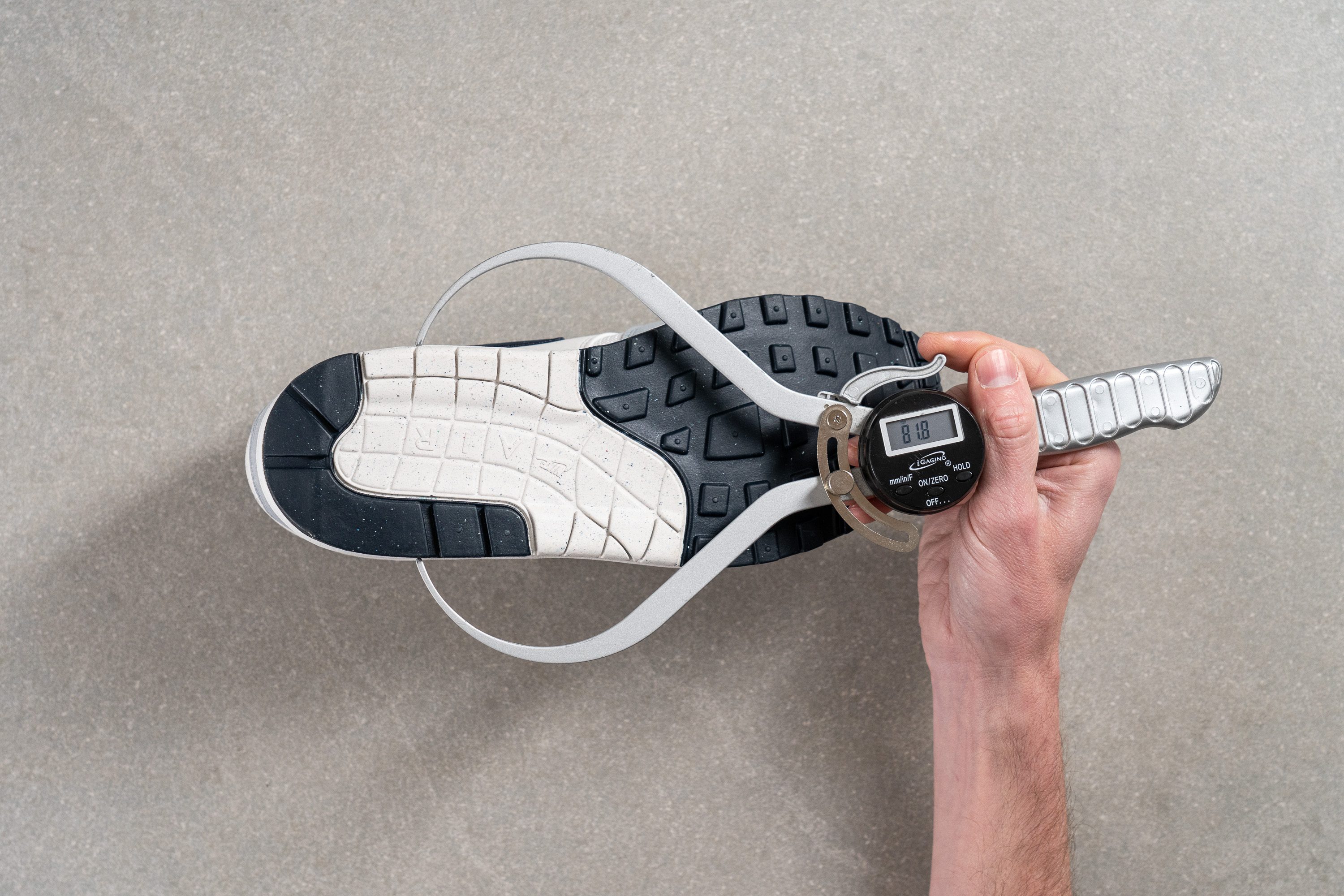
It shows 81.8 mm in the widest part of the heel which is nearly the same as the average.
| Air Max 1 | 81.8 mm |
| Average | 84.0 mm |
Durability
Leather/Suede quality
Gone are the days when you could cop a genuine leather sneaker for £140. As the Nike Air Max 1 shows, you can expect nothing more than synthetic materials at this price point.
And if you want a touch of real leather or suede, you have to shell out £160 for the kick's Premium version.
We think that even an untrained eye can see the fakeness of materials on this Nike sneaker. But we still tested every major panel on its upper with the help of a butane torch.
Both "suede" and "leather" patches quickly caught fire and melted the moment we applied the torch, proving our assumptions.
| Air Max 1 | Fake suede |
Toebox durability
The shoe's mesh fabric may lose points for breathability but boy its durability surpasses nearly every mesh sneaker we've tested!
After being exposed to sandpaper for 12 seconds at a 5K RPM speed, the fabric showed nothing more than a chafe!
Meanwhile, most kicks ended up with see-through holes like the one on the right.
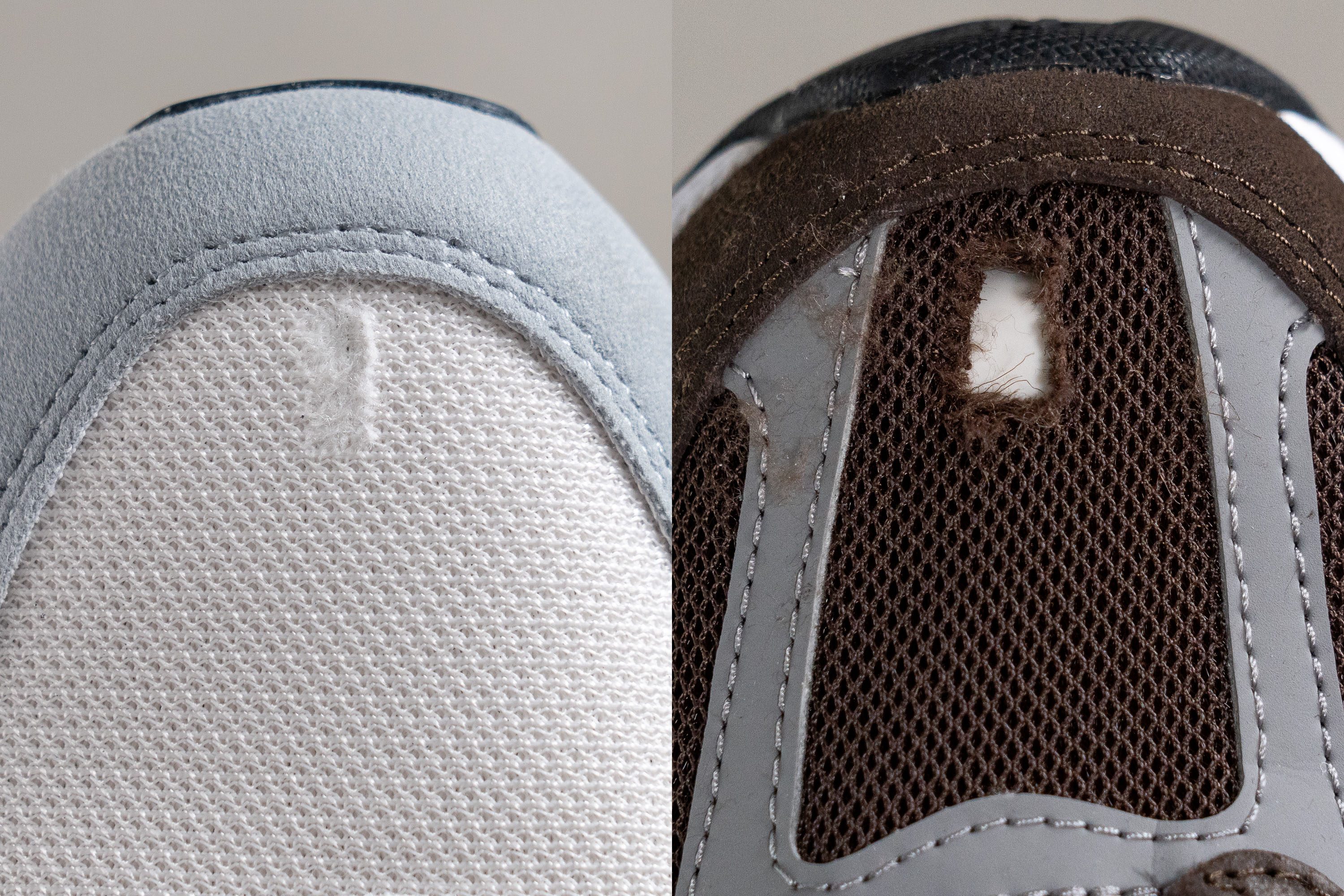
On a 1-5 scale, we eagerly rated the Air Max 1's toebox durability as 4.

In addition, the shoe's upper is protected by a large fake suede overlay around the perimeter. Proudly called the "mudguard" by Nike, it made us chuckle because it is actually a magnet for dirt and stains.
| Air Max 1 | 4 |
| Average | 3.7 |
Heel padding durability
Granted, the durability of the Air Max 1 surpassed our expectations.
Even such an easily damaged part of the shoe as the heel lining proved to be immune to our abrasive Dremel.
The textile remained nearly unscathed after a 4-second encounter with sandpaper.
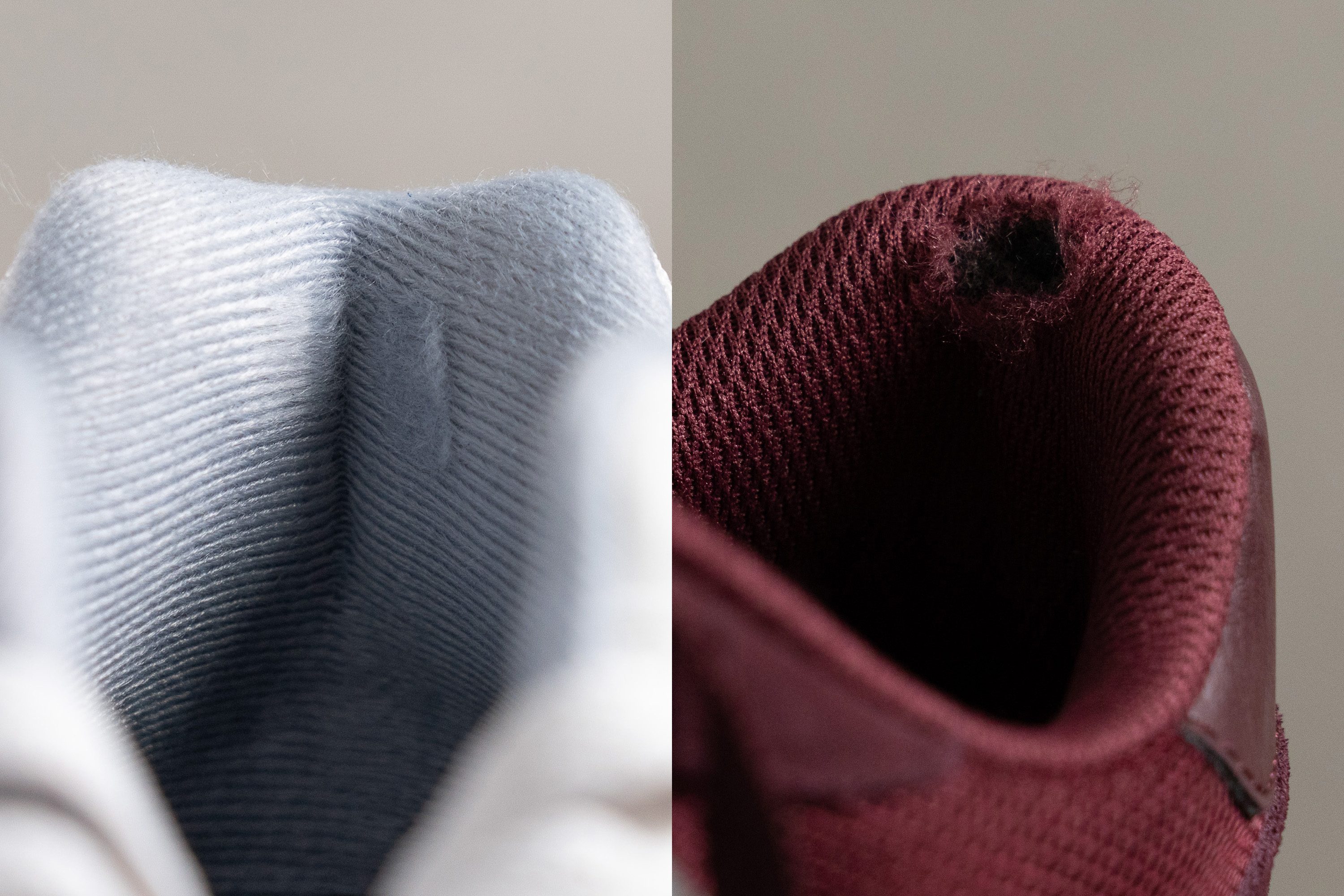
This is impressive considering that most trainers in our lab end up with considerable damage (as the shoe on the right illustrates).
Such resistance to abrasion earns the Nike Air Max 1 a high score for heel lining durability - 4 out of 5!
| Air Max 1 | 4 |
| Average | 3.2 |
Outsole hardness
Last but not least, the rubber outsole of this iconic sneaker stood up to the challenge just as brilliantly.
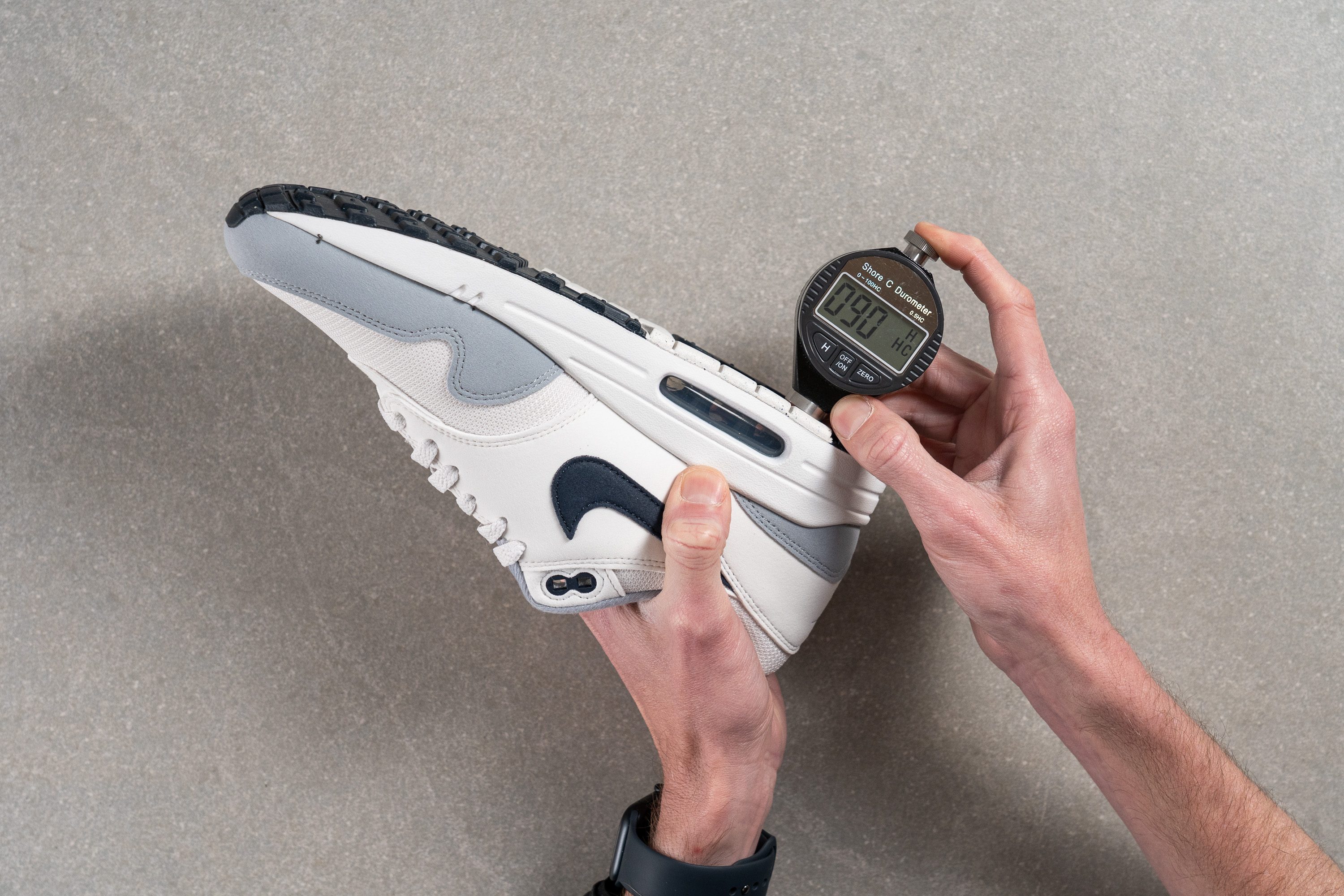
It proved to be made of a rather hard compound which returned 90.0 HC on our Shore C durometer. As one of the hardest outsole measurements in our lab, it promises a great deal of longevity as well.
| Air Max 1 | 90.0 HC |
| Average | 85.7 HC |
Outsole durability
To check if that's true, we raised the speed of our Dremel to the relentless 10K RPM and extended the drilling time to 22 seconds.
The Air Max 1 did not disappoint taking all of that abuse with minimal damage!
Measuring the depth of the dent created by the Dremel, our tread gauge showed only 0.8 mm. A bit shallower than average, it proves that this Nike sneaker has the potential to outlast most lifestyle trainers in your closet.

| Air Max 1 | 0.8 mm |
| Average | 1.1 mm |
Outsole thickness
We must also note that the thickness of rubber on the Air Max 1 comes in high at 5.7 mm. It further proves our point that it will take a while to blow through this kick.
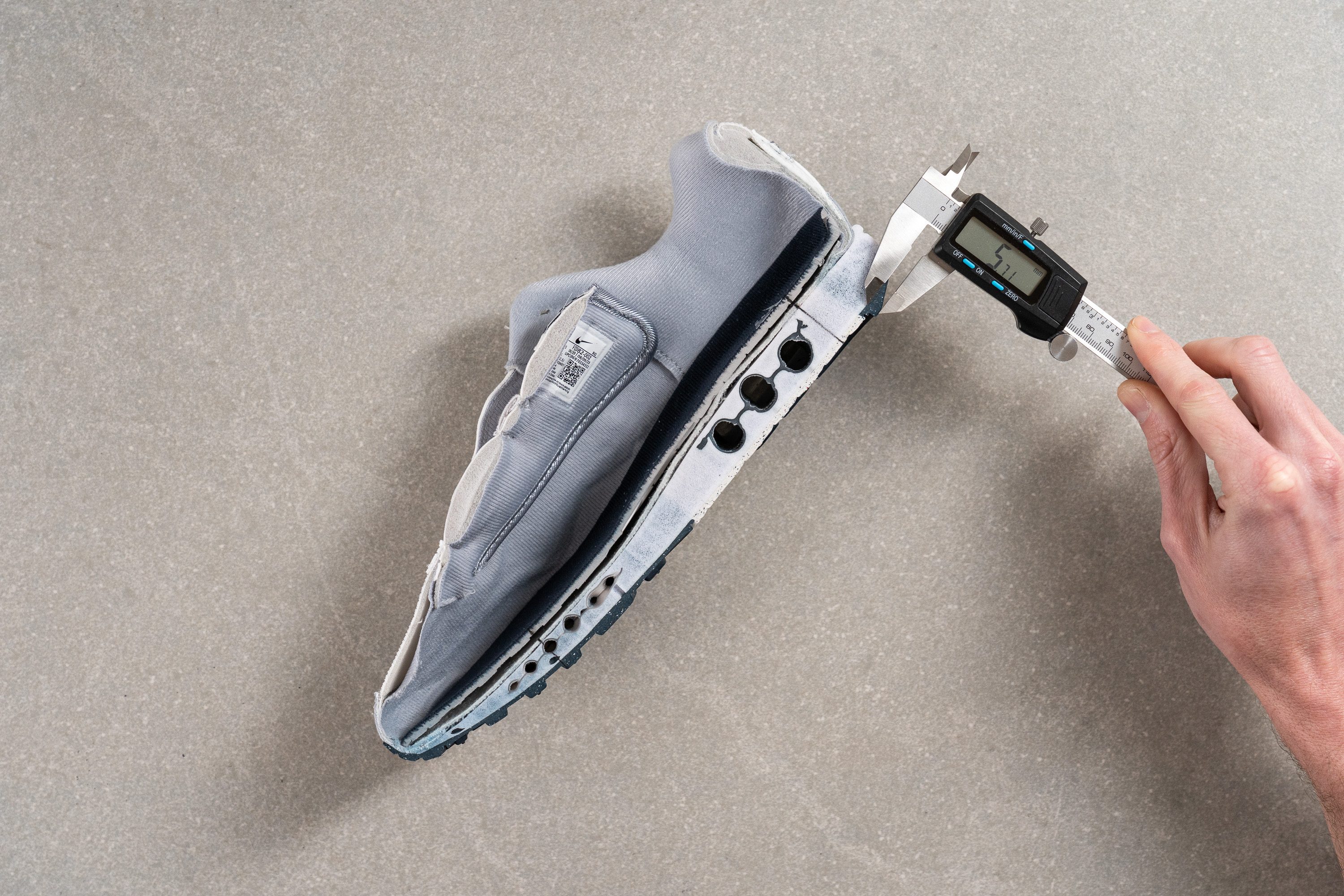
| Air Max 1 | 5.7 mm |
| Average | 5.3 mm |
Misc
Insole thickness
The Air Max 1 features a pretty minimal insole that is only 3.6 mm thick. It makes the shoe feel less cushy but you get to experience the Air Max more closely in action.
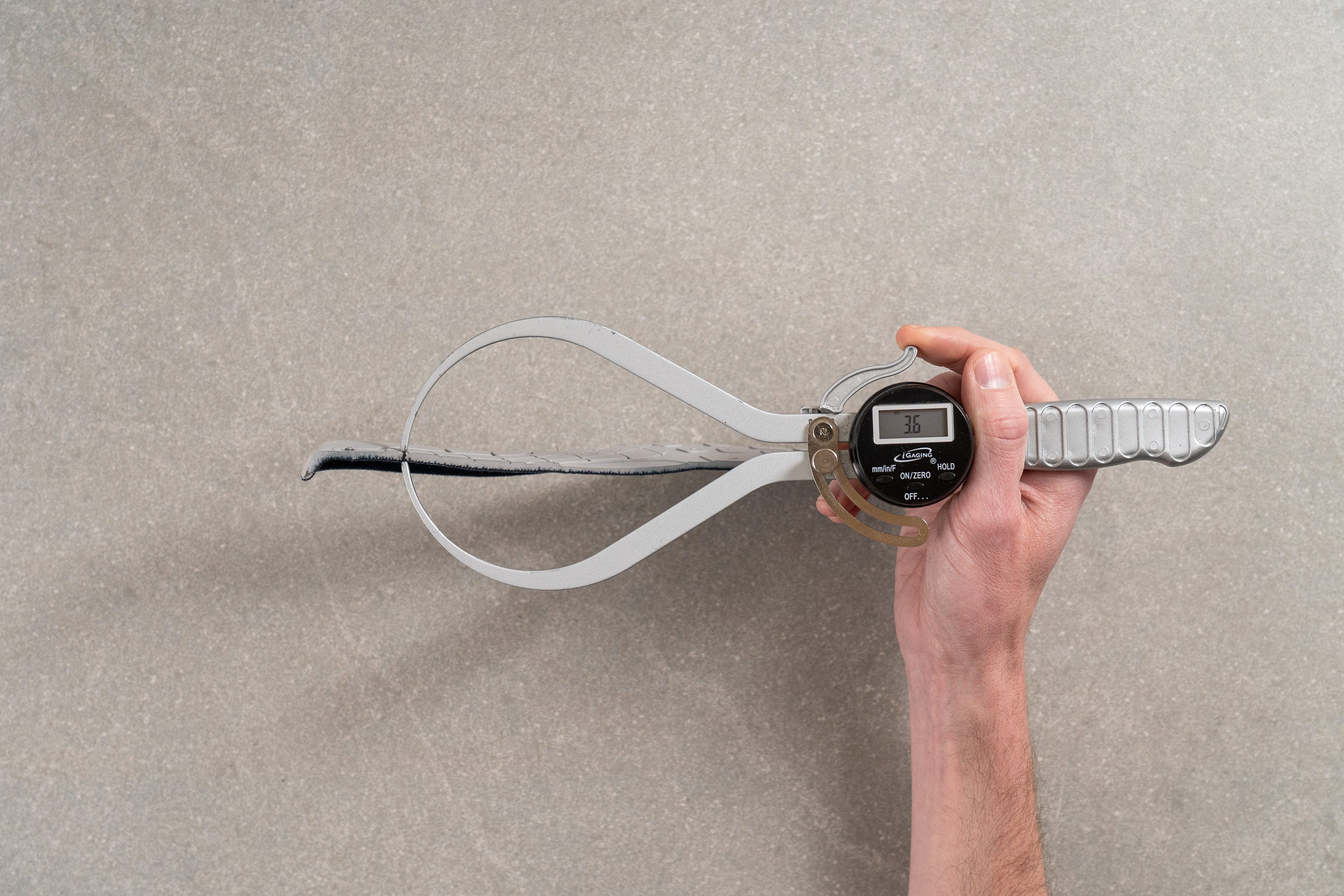
| Air Max 1 | 3.6 mm |
| Average | 5.1 mm |
Removable insole
The shoe's stock insole can be removed in a matter of seconds in case you plan to use a pair of custom orthotics with this sneaker.

| Air Max 1 | Yes |
Reflective elements
There are no reflective elements on the upper of the Air Max 1.
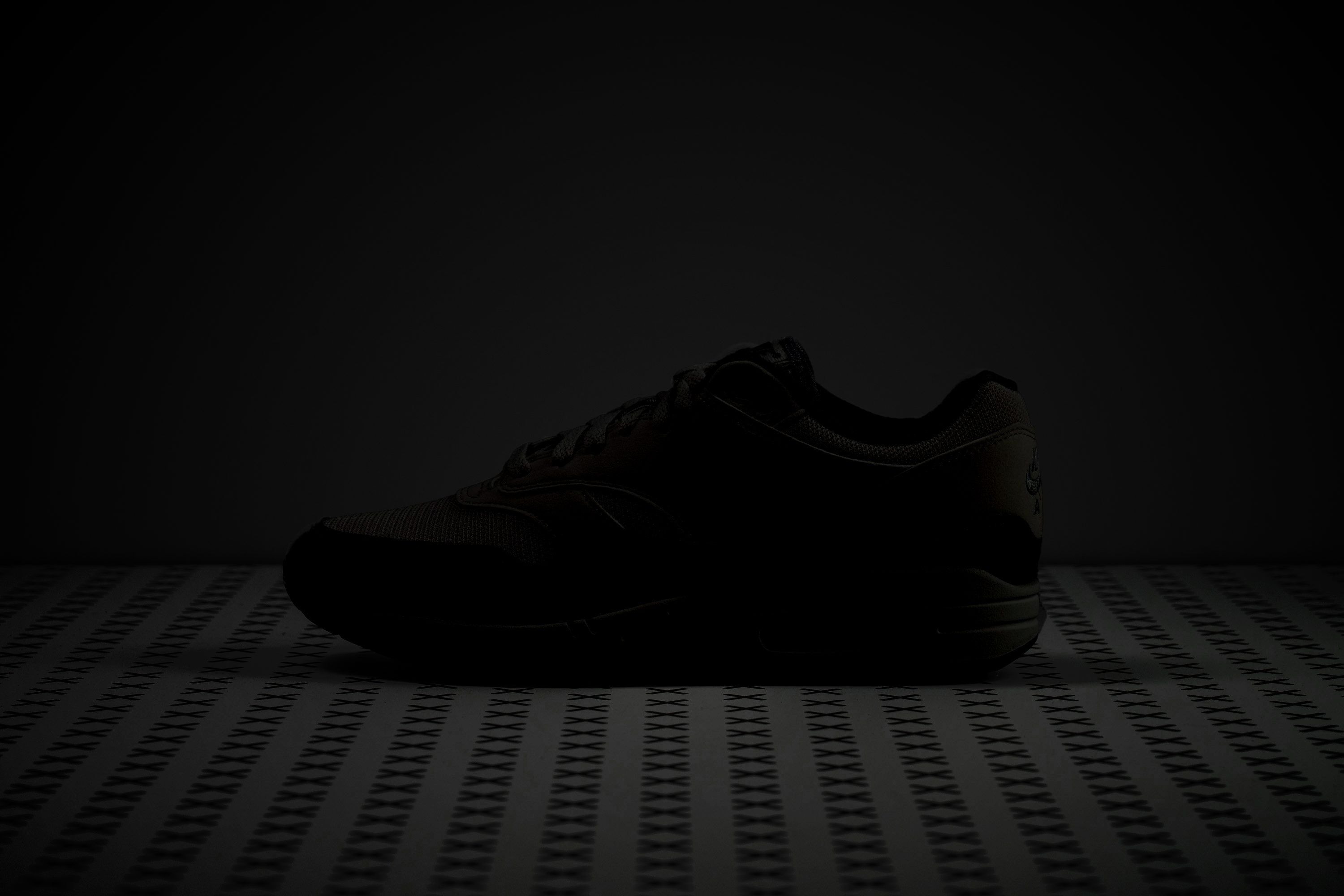
| Air Max 1 | No |
Tongue padding
The in-shoe padding of the Nike Air Max 1 is not overly abundant but it's not minimal either. We found it to be just right for keeping us comfortable.
Two foam pillows inside the tongue protected our feet from lace bites and pressure rather well.

| Air Max 1 | 9.0 mm |
| Average | 9.6 mm |
Tongue: gusset type
The tongue of the Air Max 1 does not have any gussets or other attachments to the rest of the upper.
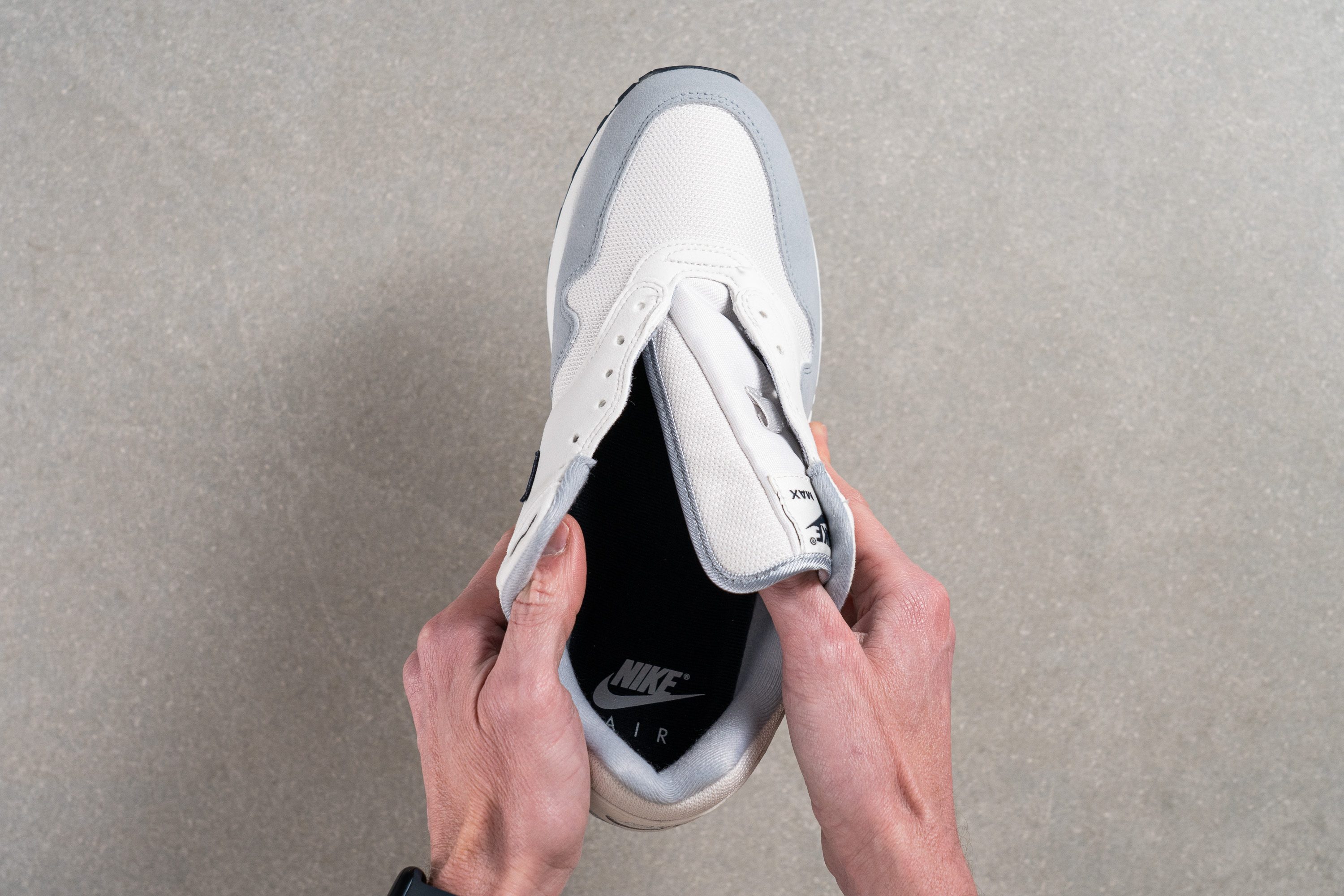
| Air Max 1 | None |
Heel tab
The Air Max 1 doesn't provide any loops or pull tabs to assist the on-and-off. You will need to fiddle with the laces a bit.

| Air Max 1 | None |
The origins of the Nike Air Max 1
The Nike Air Max 1 was not the first shoe to feature the revolutionary Air cushioning unit. It was the Nike Tailwing back in 1979. But the Air Max 1 did become the very first sneaker to put this technology on public display.
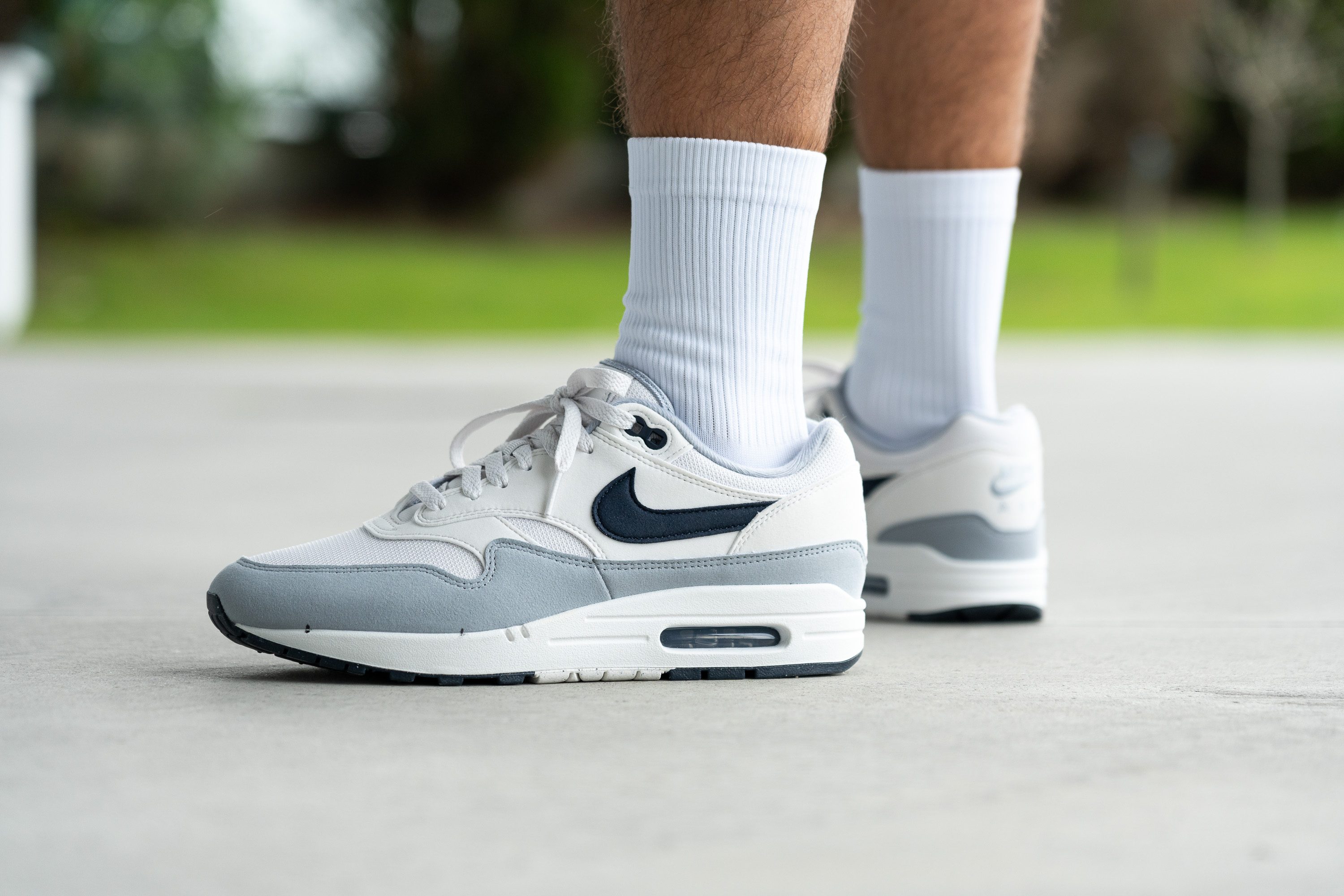
In the '80s, Nike thought of conceiving a footwear design that would keep up with the stiff competition in the shoe industry. While vibrant hues and bold patterns ruled the market, Nike planned on offering a design that is still remarkable without the usually bright and audacious elements.
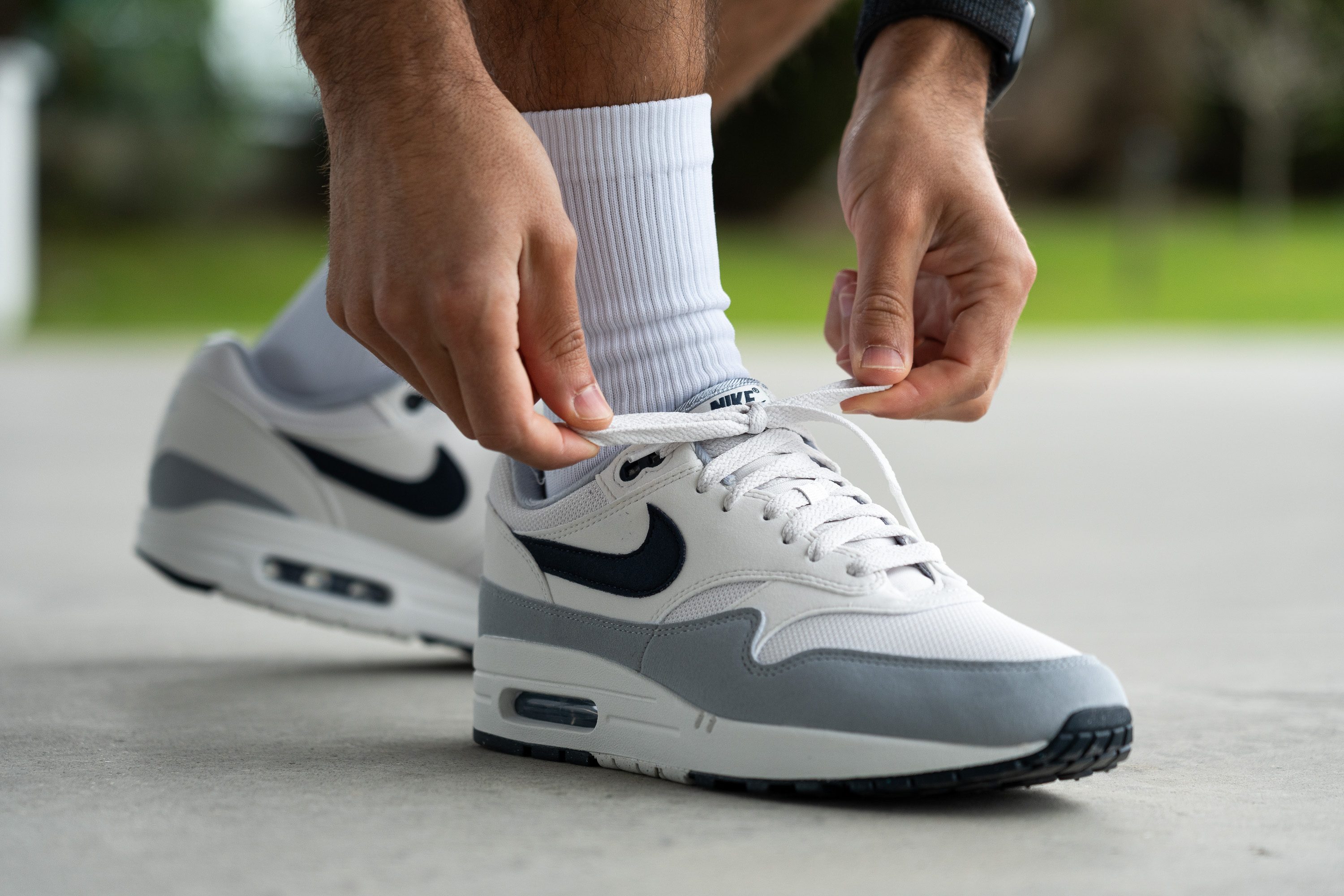
Tinker Hatfield, the brand's architect at the time, came up with the idea of making the Air unit visible during his trip to Paris. He was inspired by the unconventional design of the Centre Georges Pompidou which looked like the building was turned inside out with its girders and pipes all exposed.
The idea was originally met with resistance from Nike's marketing team and nearly cost Hatfield his job!
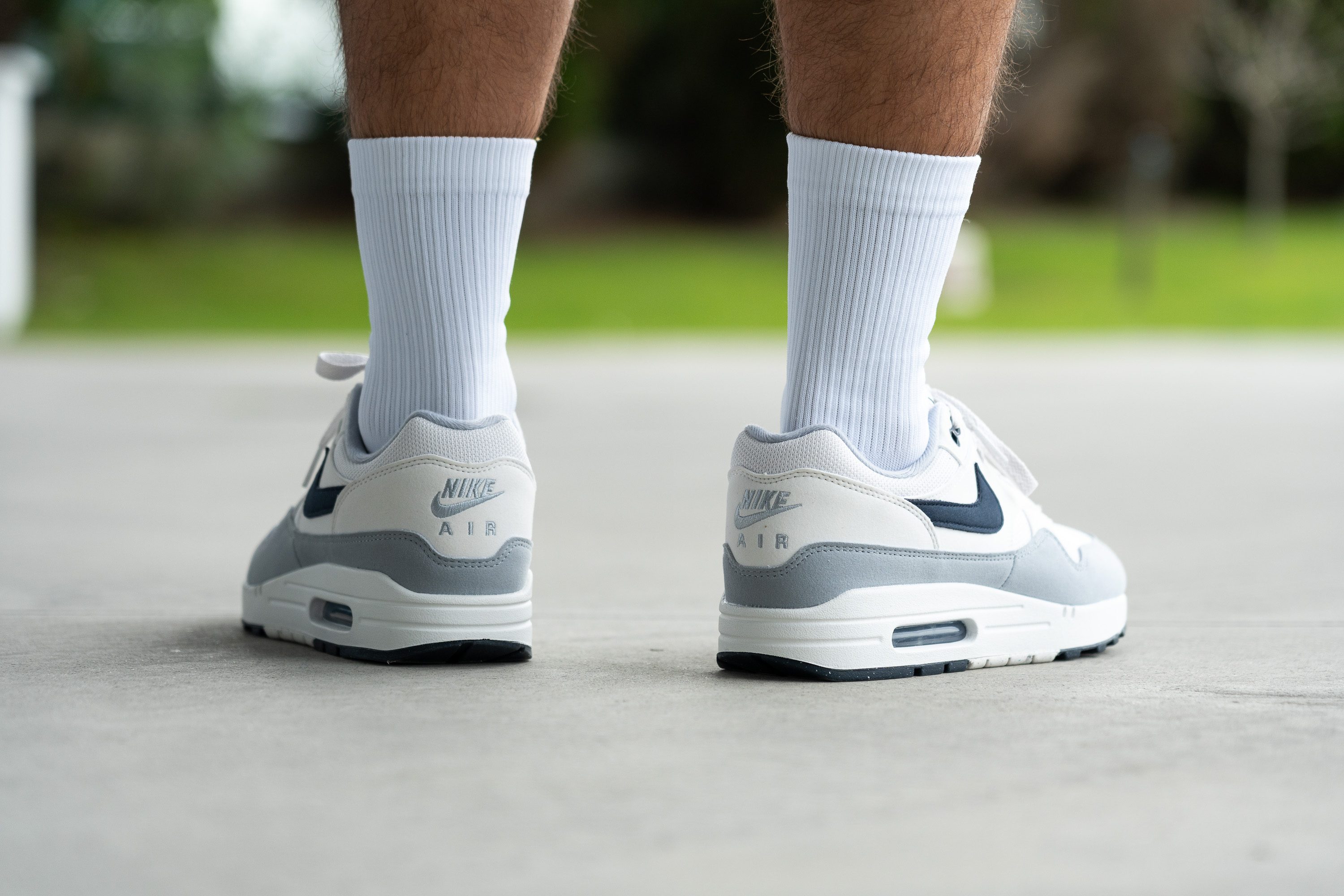
And yet, the brand yielded and the very first Nike Air Max 1 came to prominence in March 1987. Did you know that in 2014 Nike declared March 26 the official Air Max day? Since then, the company has celebrated the OG annually releasing new editions and colorways of the shoe.
The AM1's visible Air technology turned the sneaker into an instant classic. Today it is available in countless collaborations and colorways appealing to all genders, ages, and social groups.


